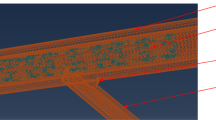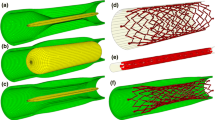Abstract
The most common approach to treat atherosclerosis in coronary bifurcations is the provisional side-branch (PSB) stenting, which consists sequentially of the insertion of a stent in the main branch (MB) of the bifurcation and a dilatation of the side branch (SB) passing through the struts of the stent at the bifurcation. This approach can be followed by a redilatation of the MB only or by a Final Kissing Balloon (FKB) inflation, both strategies leading to a minor stent distortion in the MB. The positioning of the stent struts in the bifurcation and the stresses generated in the stent and vessel wall are worthy of investigation for a better understanding of the mechanobiology of the system. For this purpose, a computer model of an atherosclerotic coronary bifurcation based on the finite element method was developed; the effects of performing the final redilatation with the two strategies utilising one or two balloons and those created by a different stent strut positioning around the SB were investigated. Results correlate well with previous experimental tests regarding the deformation following balloon expansion. Furthermore, results confirm firstly that the re-establishment of an optimal spatial configuration of the stent after the PSB approach is achieved with both strategies; secondly, results show that case of stent positioning with one cell placed centrally (with regard to the SB) should be preferred, avoiding the presence of struts inside the vessel lumen, which may reduce hemodynamic disturbances. The central positioning also resulted in a better solution in terms of lower stresses in the stent struts and, more importantly, in the vascular tissues.
Similar content being viewed by others
References
ABAQUS (2008) Analysis user’s manual, ver. 6.7EF
Balossino R, Gervaso F, Migliavacca F, Dubini G (2008) Effects of different stent designs on local heamodynamics in stented arteries. J Biomech 41: 1053–1061
Capelli C, Gervaso F, Petrini L, Dubini G, Migliavacca F (2009) Assessment of tissue prolapse after balloon expandable stenting: influence of stent cell geometry. Med Eng Phys 31: 441–447
Colombo A, Moses JW, Morice MC, Ludwig J, Holmes DR Jr, Spanos V, Louvard Y, Desmedt B, Di Mario C, Leon MB (2004) Randomized study to evaluate sirolimus-eluting stents implanted at coronary bifurcation lesions. Circulation 109: 1244–1249
Gasser TC, Holzapfel GA (2007) Modeling plaque fissuring and dissection during balloon angioplasty intervention. Ann Biomed Eng 35: 711–723
Gasser TC, Ogden RW, Holzapfel GA (2006) Hyperelastic modelling of arterial layers with distributed collagen fibre orientations. J R Soc Interf 3: 15–35
Gervaso F, Capelli C, Petrini L, Lattanzio S, Di Virgilio L, Migliavacca F (2008) On the effects of different strategies in modelling balloon-expandable stenting by means of finite element method. J Biomech 41: 1206–1212
Gijsen FJH, Migliavacca F, Schievano S, Socci L, Petrini L, Thury A, Wentzel JJ, van der Steen AF, Serruys PW, Dubini G (2008) Simulation of stent deployment in a realistic human coronary artery. Biomed Eng Online Aug 6 7: 23
Hariton I, DeBotton G, Gasser TC, Holzapfel GA (2007) Stress-modulated collagen fiber remodeling in a human carotid bifurcation. J Theor Biol 248: 460–470
Holzapfel GA, Sommer G, Gasser CT, Regitnig P (2005) Determination of layer-specific mechanical properties of human coronary arteries with nonatherosclerotic intimal thickening and related constitutive modeling. Am J Physiol Heart Circ Physiol 289: H2048–H2058
Iakovou I, Colombo A (2005) Contemporary stent treatment of coronary bifurcations. J Am Coll Cardiol 46: 1446–1455
Kiousis D, Gasser T, Holzapfel GA (2007) A numerical model to study the interaction of vascular stents with human atherosclerotic lesions. Ann Biomed Eng 35: 1857–1869
Lally C, Dolan F, Prendergast PJ (2005) Cardiovascular stent design and vessel stresses: a finite element analysis. J Biomech 38: 1574–1581
Liang DK, Yang DZ, Qi M, Wang WQ (2005) Finite element analysis of the implantation of a balloon-expandable stent in a stenosed artery. Int J Cardiol 104: 314–318
Loree HM, Tobias BJ, Gibson LJ, Kamm RD, Small DM, Lee RT (1994) Mechanical properties of model atherosclerotic lesion lipid pool. Arterioscler Thromb Vasc Biol 14: 230–234
Medina A, de Lezo JS, Pan M (2006) A new classification of coronary bifurcation lesion. Rev Esp Cardiol 59: 183–184
Migliavacca F, Petrini L, Montanari V, Quagliana I, Auricchio F, Dubini G (2005) A predictive study of the mechanical behaviour of coronary stents by computer modeling. Med Eng Phys 27: 13–18
Morice MC, Serruys PW, Sousa JE, Fajadet J, Ban Hayashi E, Perin M, Colombo A, Schuler G, Barragan P, Guagliumi G, Molnar F, Falotico R (2002) A randomized comparison of a sirolimus-eluting stent with a standard stent for coronary revascularization. N Engl J Med 346: 1773–1780
Mortier P, De Beule M, Van Loo D, Verhegghe B, Verdonck P (2009a) Finite element analysis of side branch access during bifurcation stenting. Med Eng Phys 31: 434–440
Mortier P, Holzapfel GA, De Beule M, Van Loo D, Taeymans Y, Segers P, Verdonck P, Verhegghe B (2009b) A novel simulation strategy for stent insertion and deployment in curved coronary bifurcations: comparison of three drug-eluting stents. Ann Biomed Eng [Epub ahead of print]
Moses JW, Nikolsky E, Mehran R, Cambier PA, Bachinsky WB, Leya F, Kuntz RE, Popma JJ, Schleckser P, Wang H, Cohen SA, Leon MB (2006) SIRIUS 2.25 investigators. Safety and efficacy of the 2.25- mm sirolimus eluting Bx velocity stent in the treatment of patients with de novo native coronary artery lesions: the SIRIUS 2.25 trial. Am J Cardiol 98: 1455–1460
Ormiston JA, Webster MWI, Ruygrok PN, Stewart JT, White HD, Scott DS (1999) Stent deformation following simulated side branch dilatation: a comparison of five stent design. Catheter Cardiovasc Interv 47: 258–264
Ormiston JA, Webster MWI, Seifeddin ELJ, Ruygrok PN, Stewart JT, Scott D, Currie E, Panther MJ, Shaw B, O’Shaughnessy B (2006) Drug-eluting stents for coronary bifurcations: bench testing of provisional side-branch strategies. Catheter Cardiovasc Interv 67: 49–55
Ormiston JA, Webster MWI, Webber B, Stewart JT, Ruygrok PN, Hatrick RI (2008) The “crush” technique for coronary artery bifurcation stenting: insight from micro-computed tomographic imaging of bench deployment. JACC Cardiovasc Interv 1: 351–357
Pericevic I, Lally C, Toner D, Kelly DJ (2009) The influence of plaque composition on underlying arterial wall stress during stent expansion: the case for lesion-specific stents. Med Eng Phys 31: 428–433
Sheiban I, Omedè P, Biondi-Zoccai G, Moretti C, Sciuto F, Trevi GP (2009) Update on dedicated bifurcation stents. J Interv Cardiol 22: 150–155
Wu W, Wang WQ, Yang DZ, Qi M (2007) Stent expansion in curved vessel and their interactions: a finite element analysis. J Biomech 40: 2580–2585
Zunino P, D’Angelo C, Petrini L, Vergara C, Capelli C, Migliavacca F (2009) Numerical simulation of drug eluting coronary stents: mechanics, fluid dynamics and drug release. Comput Method Appl Mech Eng 198(45–46): 3633–3644. doi:10.1016/j.cma.2008.07.019
Author information
Authors and Affiliations
Corresponding author
Rights and permissions
About this article
Cite this article
Gastaldi, D., Morlacchi, S., Nichetti, R. et al. Modelling of the provisional side-branch stenting approach for the treatment of atherosclerotic coronary bifurcations: effects of stent positioning. Biomech Model Mechanobiol 9, 551–561 (2010). https://doi.org/10.1007/s10237-010-0196-8
Received:
Accepted:
Published:
Issue Date:
DOI: https://doi.org/10.1007/s10237-010-0196-8




